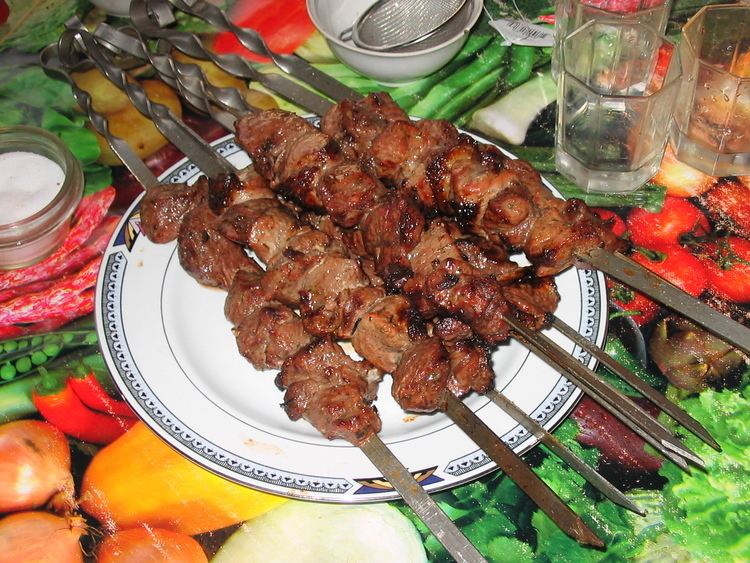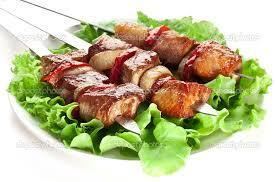Course Main course Main ingredients Meat, marinade, onions | Serving temperature Hot | |
Place of origin Caucasus
Eastern Europe
Western, Southern and Central Asia Region or state Afghanistan, Armenia, Azerbaijan, Bangladesh Similar Zakuski, Kebab, Pilaf, Pelmeni, Borscht | ||
Chicken shashlik cook with saima
Shashlik or shashlyk (Persian: شیشلیک – Šišlik, Armenian: խորոված khorovats, Azerbaijani: şişlik or tikə kabab, Georgian: მწვადი mtsvadi, Russian: шашлы́к, Ukrainian: шашли́к, Polish: Szaszłyk, Lithuanian: šašlykas, Turkish: şaşlık, Hebrew: שישליק, Urdu: شاشلِک ), is a dish of skewered and grilled cubes of meat popular in Iran, Eastern and Central Europe (Russia, Ukraine, Belarus, Romania, Bulgaria, Poland, Hungary), the Baltic region in Northern Europe (Latvia, Lithuania, Estonia), the Caucasus (Armenia, Azerbaijan, Georgia), Central Asia, Afghanistan, Israel, Iraq, Mongolia, Morocco, Pakistan, Turkey, and other places.
Contents
- Chicken shashlik cook with saima
- Chicken shashlik original restaurant recipe by cooking hands
- Usage
- Preparation
- Similar dishes
- References
Shashlik (meaning skewered meat) was originally made of lamb. Nowadays it is also made of pork or beef depending on local preferences and religious observances. The skewers are either threaded with meat only, or with alternating pieces of meat, fat, and vegetables, such as bell pepper, onion, mushroom and tomato.

Chicken shashlik original restaurant recipe by cooking hands
Usage

The word "shish" (Azerbaijani: şiş, Turkish: şiş) means skewer. The word "shishlik" is literally translated as "skewerable". Even though the word "shashlyk" was borrowed from the Crimean Tatars by the Cossacks as early as the 16th century, kebabs did not reach Moscow until the late 19th century. From then on, their popularity spread rapidly; by the 1910s they were a staple in St Petersburg restaurants and by the 1920s they were already a pervasive street food all over urban Russia.

While it is not unusual to see shashlik today listed on the menu of restaurants, it is more commonly sold in the form of fast-food by street vendors who roast the skewers over wood, charcoal, or coal. It is also cooked in outdoor environments during social gatherings, similarly to barbecue in English-speaking countries.
Preparation

In Iranian cuisine, meat for shashlik (as opposed to other forms of shish kebab) is usually in form of large chunks of meat, while elsewhere the form of medium-size meat cubes is maintained making it similar to brochette. The meat is marinated overnight in a high-acidity marinade like vinegar, dry wine or sour fruit/vegetable juice with the addition of onions, herbs and spices. Shashlik is usually cooked on a grill called a mangal.
Similar dishes
Recipe: How to make Shashlik
